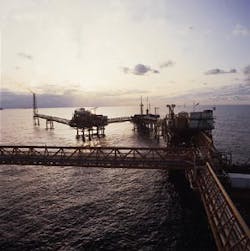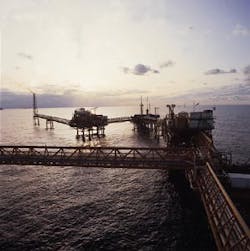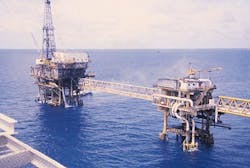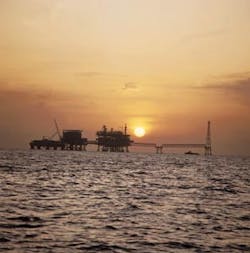GULF OF MEXICO Pemex draws up ambitious investment plans for 1997
David Shields
Mexico City
Although much of next year's investment is to come from public funds, the government's stated aim is to subcontract as much work as possible to service companies within the constitutional restrictions which apply to the oil and gas sector.
This should mean a considerably greater amount of work will be contracted out to private firms, particularly on key projects such as Cantarell, Tabasco Littoral, and development of light crude fields in the southeastern part of the Campeche offshore area.
However, private firms hoping to participate in such key projects, which mean big profits for Pemex, are expected to obtain project financing from international banks as a prerequisite for participating in the tenders. This expected financing is already included in the official US$5.91 billion investment figure. The credits will be repaid as the projects are completed and begin to make money, which usually means as soon as additional oil production from the projects comes on stream.
In a recent interview, Antonio Acu^a Rosado, head of northeastern offshore operations, said that Pemex's Exploration and Production Division will invest close to $1.8 billion in offshore operations in 1997. This figure apparently does not include the additional financing to be provided by private firms competing in tenders.
As many as 836 contracts will be tendered to private firms, 279 of which will be for construction work and 557 for other offshore services. Pemex currently has 180 platforms and other structures and 1,677 miles of pipelines in its Campeche offshore area, Acu^a Rosado mentioned.
Pemex is expected to concentrate efforts on oil and gas production in 1997 and its plans are to push up output of both 8% nationwide against the 1996 average of 2.87 million b/d oil and 4.2 billion cf/d gas. Crude oil production is thus expected to reach a record 3.1 million b/d next year, with close to 2.3 million b/d coming from the offshore area.
According to Acu^a Rosado, the offshore area produced 2,129,468 b/d oil and 1.57 bcf/d gas in the first ten months of 1996.
The government has been encouraged to spend more on the oil industry by recent high oil prices and high world demand. Pemex had income of $7.6 billion from oil sales in the first three quarters of 1996, which is more than the company usually earns for a whole year. The full year's figure for 1996 will be close to $10.5 billion, with close to 75% of production coming from the offshore area. Gross profits at Pemex were $5.59 billion for the January-September period, 25% higher than a year earlier.
The Cantarell Project is a $4 billion investment program to improve exploitation of the Cantarell offshore oil field, which is the biggest in Mexico, currently providing 1.1 million b/d oil and 450 million cf/d gas. The field provides more than a third of Mexico's total crude oil output in volume terms and has done so since the early Eighties.
The program proposes to increase production by an average of 150,000 b/d, stop burning off gas at wellheads, and develop a program to maintain oilflow pressures in the field through gas injection. It also involves building oil and gas pipelines, using new production platforms, and installing compressors, pumps, and automated control equipment.
One billion dollars is to be spent on Cantarell in each of the next four years. The tenders are expected over the next few months. Bechtel will be the technical advisor on the project.
Cantarell, together with the Cadereyta Project, a billion-collar refining upgrade, are being touted by the Mexican government as projects that will reactivate economic growth.
Several Mexican construction companies, headed by Protexa, ICA, Bufete Industrial, and Tribasa, have announced their intention to pool together their financial and technical resources in order to bid on both projects, in the hope that not all the tenders will go to foreign firms. the four may even be able to finance the projects with their own resources., spokesmen from the companies have said. However, a number of foreign companies are expected to win some of the tenders and get involved on Cantarell.
Not long ago, the Campeche offshore area of Pemex's Exploration and Production Division was divided into two sections for operating purposes: the Northeastern Region, with mainly heavy crude deposits, including Cantarell, and the Southwestern Region, with mainly light crude deposits and big gas-to-oil ratios.
The Southwestern Region has some key projects, too. It is preparing to tender engineering and construction work on a 36-inch diameter gas pipeline to take natural gas over a 48-mile stretch from key light crude deposits, known as Abkatun, Chuc, and Caan (among other fields) in offshore Campeche to collection and compression facilities at Dos Bocas, Tabasco.
The cost of the pipeline is estimated at $120 million and it is currently the biggest project waiting to be tendered in offshore Campeche. Two other key projects to be tendered in the Southwestern offshore zone are a $112 million, 330 million cf/d gas compression platform and a $103 million, 110 million cf/d gas compression module.
Few new oil and gas discoveries were announced in 1996, but there was news in November of one relatively important new offshore light crude oil find, known as Manik. the Manik-1 exploratory well flowed at 7,500 b/d oil and 6 million cf/d gas. The discovery confirmed a continuation of the existing offshore light crude fields, known as Caan, Abkatun, and Taratunich, which together account for 450,000 b/d of oil production. Indications are that light crude fields form a belt from the southwest of the Campeche offshore area to the Tabasco coastline.
Pemex's investment plans for 1997 also include the development of wells in the Tabasco Littoral, a light crude area whose discovery was announced early in 1995. It lies between the Southwestern offshore region and the onshore Tabasco plays. Investment in the project is estimated at $485 million in 1997 alone.
Some private contractors, however, have some doubts about whether Pemex is ready to spend the almost $6 billion budget authorized for 1997. They are worried that the plans and preliminary work are not ready yet, either on paper or in terms of basic infrastructure being prepared in the field, for Pemex to spend such a large amount.
Another problem which often hampers public spending in the oil industry is that the Finance Ministry is often slow to release the approved financing. Moreover, it often puts pressure on Pemex at some point during the year to try to restrict its expenditures in order to prevent overheating of public spending.
In most recent years, Pemex has actually spent considerably less than the amount of approved public spending, especially in areas such as maintenance and industrial safety. Nevertheless, it seems certain that real expenditures at Pemex will be noticeably higher this year than in recent years.
Copyright 1997 Offshore. All Rights Reserved.



